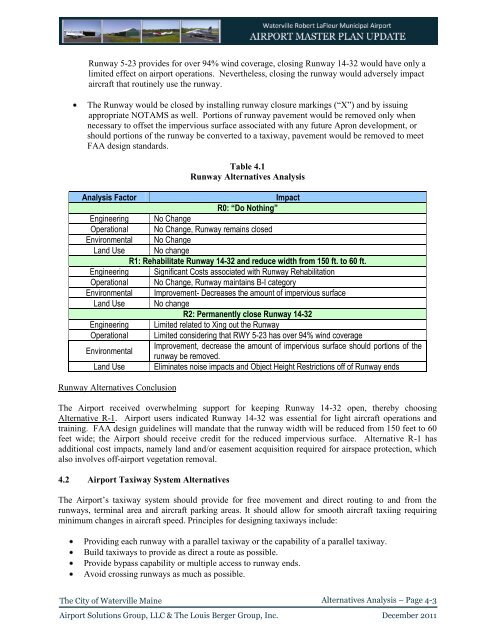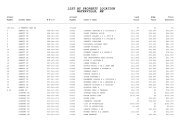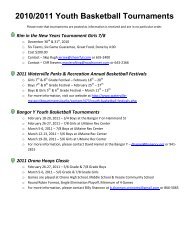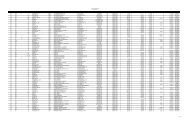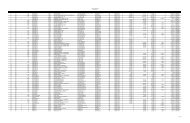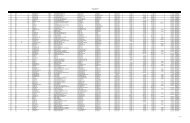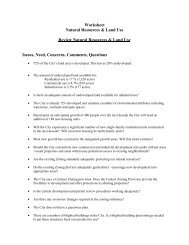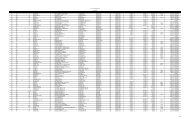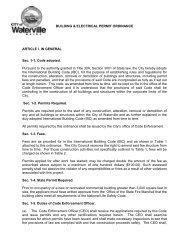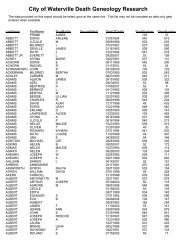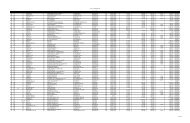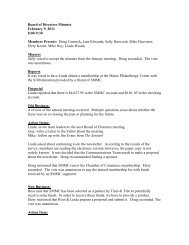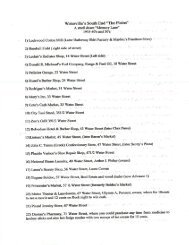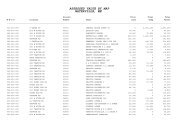Airport Master Plan 2012 - City of Waterville
Airport Master Plan 2012 - City of Waterville
Airport Master Plan 2012 - City of Waterville
You also want an ePaper? Increase the reach of your titles
YUMPU automatically turns print PDFs into web optimized ePapers that Google loves.
Runway 5-23 provides for over 94% wind coverage, closing Runway 14-32 would have only a<br />
limited effect on airport operations. Nevertheless, closing the runway would adversely impact<br />
aircraft that routinely use the runway.<br />
The Runway would be closed by installing runway closure markings (“X”) and by issuing<br />
appropriate NOTAMS as well. Portions <strong>of</strong> runway pavement would be removed only when<br />
necessary to <strong>of</strong>fset the impervious surface associated with any future Apron development, or<br />
should portions <strong>of</strong> the runway be converted to a taxiway, pavement would be removed to meet<br />
FAA design standards.<br />
Table 4.1<br />
Runway Alternatives Analysis<br />
Analysis Factor<br />
Impact<br />
R0: “Do Nothing”<br />
Engineering No Change<br />
Operational No Change, Runway remains closed<br />
Environmental No Change<br />
Land Use No change<br />
R1: Rehabilitate Runway 14-32 and reduce width from 150 ft. to 60 ft.<br />
Engineering Significant Costs associated with Runway Rehabilitation<br />
Operational No Change, Runway maintains B-I category<br />
Environmental Improvement- Decreases the amount <strong>of</strong> impervious surface<br />
Land Use No change<br />
R2: Permanently close Runway 14-32<br />
Engineering Limited related to Xing out the Runway<br />
Operational Limited considering that RWY 5-23 has over 94% wind coverage<br />
Environmental<br />
Improvement, decrease the amount <strong>of</strong> impervious surface should portions <strong>of</strong> the<br />
runway be removed.<br />
Land Use Eliminates noise impacts and Object Height Restrictions <strong>of</strong>f <strong>of</strong> Runway ends<br />
Runway Alternatives Conclusion<br />
The <strong>Airport</strong> received overwhelming support for keeping Runway 14-32 open, thereby choosing<br />
Alternative R-1. <strong>Airport</strong> users indicated Runway 14-32 was essential for light aircraft operations and<br />
training. FAA design guidelines will mandate that the runway width will be reduced from 150 feet to 60<br />
feet wide; the <strong>Airport</strong> should receive credit for the reduced impervious surface. Alternative R-1 has<br />
additional cost impacts, namely land and/or easement acquisition required for airspace protection, which<br />
also involves <strong>of</strong>f-airport vegetation removal.<br />
4.2 <strong>Airport</strong> Taxiway System Alternatives<br />
The <strong>Airport</strong>‟s taxiway system should provide for free movement and direct routing to and from the<br />
runways, terminal area and aircraft parking areas. It should allow for smooth aircraft taxiing requiring<br />
minimum changes in aircraft speed. Principles for designing taxiways include:<br />
Providing each runway with a parallel taxiway or the capability <strong>of</strong> a parallel taxiway.<br />
Build taxiways to provide as direct a route as possible.<br />
Provide bypass capability or multiple access to runway ends.<br />
Avoid crossing runways as much as possible.<br />
The <strong>City</strong> <strong>of</strong> <strong>Waterville</strong> Maine<br />
Alternatives Analysis – Page 4-3<br />
<strong>Airport</strong> Solutions Group, LLC & The Louis Berger Group, Inc. December 2011


